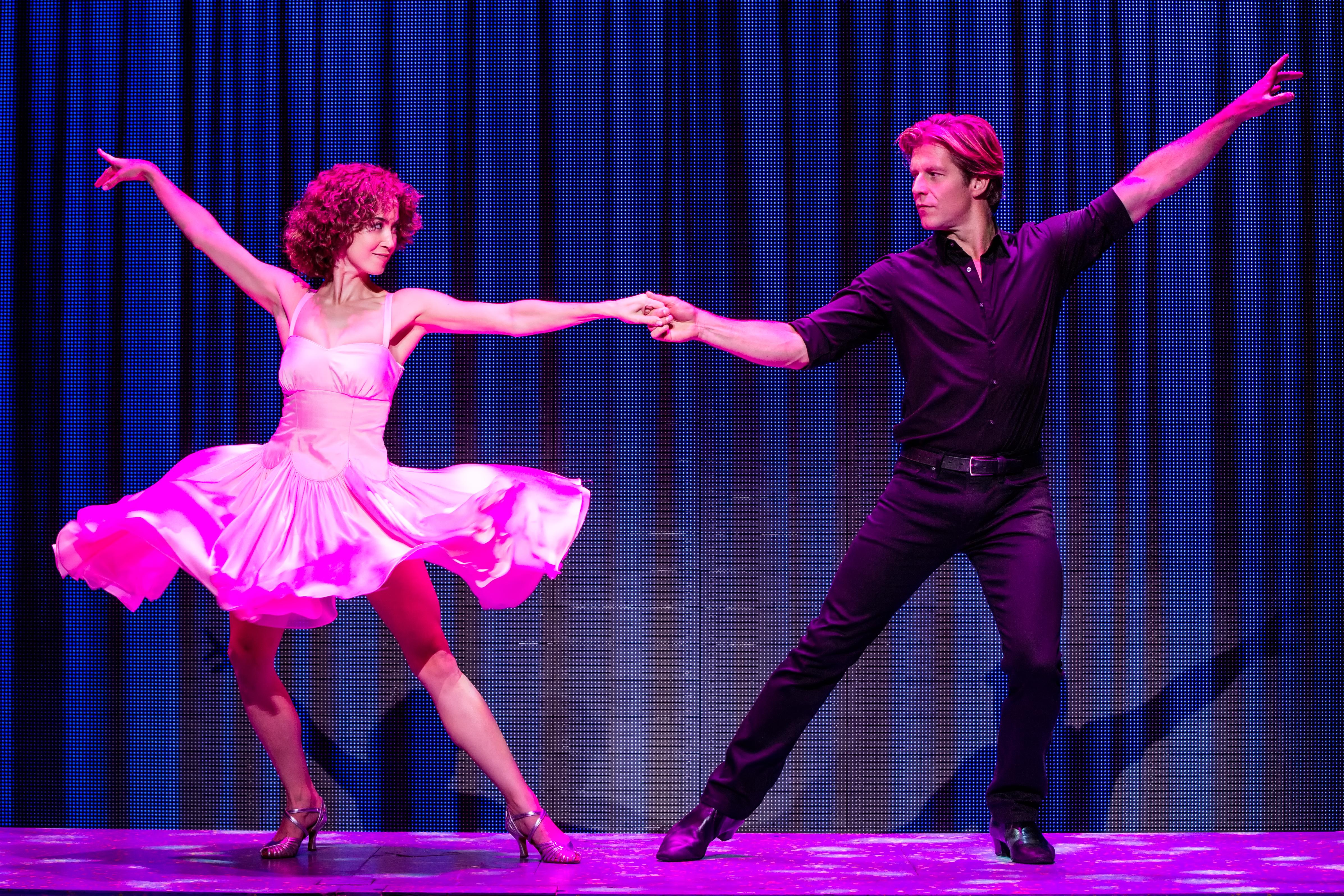REVIEW BY CARY GINELL
The success of the awkwardly titled Dirty Dancing: The Classic Story on Stage depends primarily on whether or not you were a fan of the motion picture it was closely modeled after. It’s easy to say this since the stage version is nearly identical to the film, and in many ways works better as a live production. For the uninitiated or those who steered clear of the film, Dirty Dancing was one of the most successful motion pictures of the 1980s. The low-budget film became a surprise hit, earning $214 million at the box office and becoming the first film to sell more than a million copies on home video. The soundtrack LP, featuring a combination of original songs and vintage hits from the early 1960s, sold 32 million copies and spent four months on top of the best-selling album charts. Looking at the film from today’s perspective, 30 years later, one wonders why it was so big. Though many remember the film as a charming coming-of-age story, critics called it “schmaltzy,” citing the formulaic portrayal of its stock characters spouting trite dialog.
Dirty Dancing is probably all of the above. When you boil it down, its chief attractions were the lusty title, the impressive dancing, and its penultimate super-hit, “(I’ve Had) The Time of My Life.” The recording of the latter, by Bill Medley and Jennifer Warnes became one of the signature hits of the soundtrack mad eighties. Theater League’s North American tour of the show (be careful calling it a musical, because it really isn’t one), which plays at the Thousand Oaks Civic Arts Plaza through Sunday, February 6, has much of the charm of the film thanks to its lead characters, hunky summer camp dance teacher Johnny Castle and rich kid teenager Frances “Baby” Houseman. The story takes place in the summer of 1963. Baby and her affluent family come to Camp Kellerman, an upscale resort loosely based on summer camps in the Catskills, where they settle in for a vacation of white bread games like Simon Says, watermelon eating contests, and singing folk songs around the ol’ campfire. Unbeknownst to the campers, the camp staff is engaging in lascivious dancing and bed-hopping in their after-hours activities. When Baby discovers this alternate world, she falls for Johnny, starting a kind of West Side Story forbidden relationship.
Bronwyn Reed is appealing as Baby, a character that goes through a wide development arc, beginning as a shy, awkward daddy’s girl, and then becoming a skillful dancer, eager lover, and an idealistic, forceful, and confident young woman. It takes a lot of talent for a good dancer to be convincing as a beginner, but Reed, who spent stints with both the Joffrey Ballet and the American Ballet Theatre, does just that. Christopher Tierney plays Johnny Castle with an added sensitivity and resists the urge to play him as a pale copy of Danny Zuko (Grease). Johnny is basically an average Joe stuck in a job doing the only thing he can do well (reminding one of a different John Travolta character, Tony Manero in Saturday Night Fever).
The best scenes in Dirty Dancing: The Classic Story on Stage are those between Reed and Tierney. When Tierney’s regular dance partner, the willowy blonde Penny, played on opening night by Kellie Drobnick, becomes pregnant and has an abortion, Baby is called upon to fill in, with Johnny giving her a week’s worth of marathon mambo lessons. Video and projection designer Jon Driscoll did a fabulous job creating the montage of scenes in which Baby’s dancing goes from laughable to sensuous, utilizing an enormous video screen taking up the entire height and width of the Kavli Theatre stage, to show Johnny teaching Baby in a field of tall, waving grass and in an expansive lake, with the characters going through their routines behind the translucent projected images. (It’s too bad they couldn’t figure out a way for their hair to get soaked after taking repeated dunks in the water…)
Drobnick, an understudy for the show’s main performer, Jennifer Mealani Jones, is a better physical match for Tierney than the diminutive Reed and is an extraordinary dancer. Tall and slim, the blonde Drobnick is 90% legs and is electrifying in her mambo routines with Tierney. This is not meant to undersell Reed’s work as a dancer; she is terrific as well, but Tierney and Drobnick’s routines are outstanding.
The rest of the cast consist of basic cookie-cutter characters with the exception of Jon Edward Powell, who has some nice moments as Baby’s doctor father, a living embodiment of the Hippocratic Oath. The music, a combination of pre-recorded period hits from the early ’60s and live performances of other vintage songs, does a lot to bring the era to life. While songs such as the Five Satins’ “In the Still of the Night,” Otis Redding’s “These Arms of Mine,” and especially, Solomon Burke’s seductive “Cry to Me” enhance Baby and Johnny’s love scenes, some of the best musical moments in the show are songs sung live by the cast’s two chief vocalists: the powerhouse Chante Carmel (whose best song was a samba version of “You Don’t Own Me”) and Jordan Edwin Andre. It should be pointed out that this may be the only “musical,” if you still insist on calling it that, where the two main love interests don’t sing love songs to one another; the songs are performed in short spurts either by its featured singers, supporting cast members, or in pre-recorded snippets.
The stage musical is almost a carbon copy of the film with the exception of a preachy, contrived scene where the camp goers listen en masse to Martin Luther King Jr.’s “I have a dream” speech and then sing “This Land Is Your Land” around a campfire. This scene is not only unnecessary (the songs set the time sufficiently well), it has little to do with the story and only proves to be a distraction that goes nowhere. Maybe this was added because the stage version, like the film, needed a little added authenticity. The hair styles and clothing in each are more reminiscent of the 1980s than the pre-Beatles 1960s. One need look no further than Baby’s Barbra Streisand frizzy Star Is Born hair and high-waisted denim cutoffs to realize this, so it’s possible the MLK references were added to help solidify the time period. But the show still screams Reagan rather than JFK.
Despite all the side trips the story takes, Dirty Dancing’s dance-as-mating-ritual story remains the primary drawing card for the show. Craig Wilson’s superb ballroom and Latin choreography is the best thing in the show, although the moves are not nearly as libidinous as they were in the film. Dirty Dancing:The Stage Show remains a highly entertained, if flawed production and worth seeing.
******************
For tickets to Dirty Dancing, visit http://theaterleague.com/thousandoaks/dirty-dancing/






No Comments